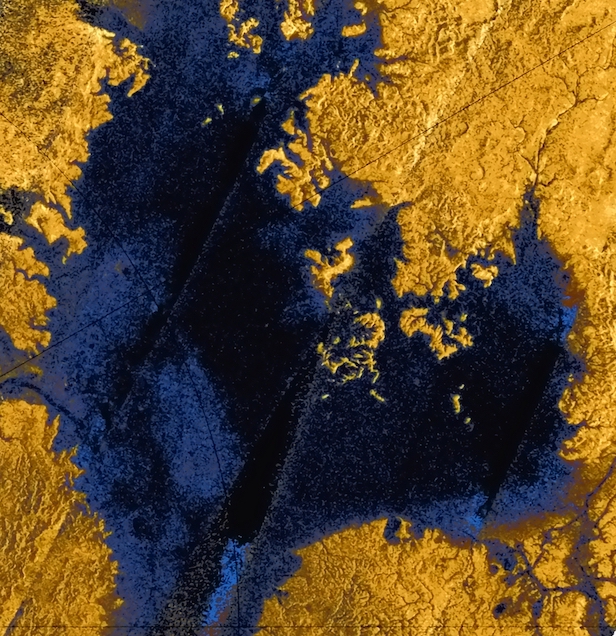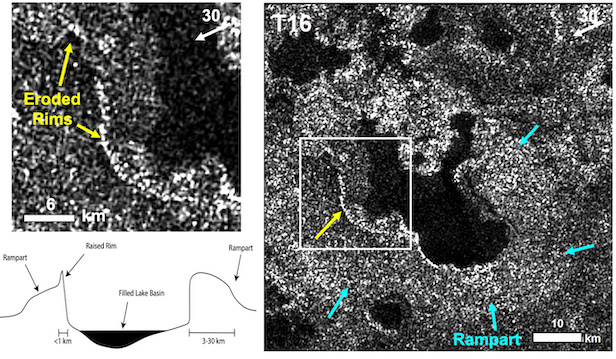Astronomers explore the ring-like structures surrounding Titan’s lakes
The analysis comes from the Cassini-Huygens mission that completed multiple flybys of the moon and even dropped a lander on the surface

Saturn’s largest moon Titan has seas and lakes filled with liquid hydrocarbons, extremely similar to the seas and lakes of liquid water on Earth. Image credit: NASA/ESA. Acknowledgement: T. Cornet, ESA
Using observations from the international Cassini spacecraft, scientists have explored the ring-like mounds that wrap around some of the pools found at the poles of Saturn’s largest moon, Titan. The study reveals more about how these features formed.
The NASA/ESA/ASI Cassini-Huygens mission spent 13 years in the Saturnian system, with the Cassini spacecraft carrying ESA’s Huygens probe, which landed on the icy moon in 2005. During Cassini’s tour of Saturn and its moons, it made more than 100 flybys of Titan, revealing around 650 lakes and seas in the polar regions of Titan – 300 of which are at least partially filled with a liquid mix of methane and ethane.
Most of Titan’s smaller lakes are characterised as sharp-edged depressions, either empty or full, with relatively flat floors, depths of up to 600 metres (1970 feet), and steep, narrow outer rims roughly one kilometre (0.6 miles) in width.
Some lakes, however, are surrounded by ramparts: ring-shaped mounds that extend for tens of kilometres from a lake’s shoreline. Unlike rims, these ramparts totally enclose their host lake.
“The formation of Titan’s lakes, and their surrounding features, remains an open question,” says Anezina Solomonidou, an ESA research fellow at the European Space Astronomy Centre (ESAC) near Madrid, Spain, and lead author of a new study into Titan’s ramparts.
“Ramparts may hold important clues about how the lake-filled polar regions of Titan became what we see today. Previous research revealed their existence, but how did they form?”
Solomonidou and her collaborators combined spectral and radar data from Cassini for the first time to explore five regions near Titan’s north pole with filled lakes and raised ramparts, and three empty lakes from a nearby region. The lakes ranged from 30 to 670 square kilometre (11 to 260 square mile) in size, and were entirely surrounded by 200 to 300 metre (660 to 980 feet)-high ramparts that sprawled outwards from the lake perimeters for up to 30 kilometres (19 miles).
The observations were gathered by Cassini over the years during Titan flybys with the Visual and Infrared Mapping Spectrometer (VIMS), which probes the top layer of the surface (tens of μm), and with the RADAR instrument, which can penetrate further, down to tens of centimetres, depending on the properties of the surface material. The latter was used in both its radiometry mode and using its Synthetic Aperture Radar (SAR) Imager.
“The spectral data showed that ramparts have a different composition with respect to their surroundings,” adds Solomonidou.
“The floors of empty lakes we studied also seem to be spectrally similar to the ramparts, suggesting that both empty basins and ramparts may be made from, or coated with, similar material, and may thus have formed in a similar way.”

These images provide a view of rampart and rim features near a lake on Titan as observed by the Cassini mission. Cassini’s RADAR image of one of Titan’s lake, Viedma Lacus, obtained using the instrument’s Synthetic Aperture Radar (SAR) Imager (right). A zoomed-in view of the raised rim (top left). Illustration of a lake with rampart and rim features (bottom left). Image credit: NASA/JPL-Caltech/ASI; ESA/A. Solomonidou et al. (2019)
The emissivity of the ramparts, as examined by co-author Alice Le Gall of UVSQ’s LATMOS laboratory in Paris, France, was also similar to that of another important and widespread feature seen on Titan, which scientists refer to as labyrinth terrain. A maze-like landscape scored with different channels formed by fluvial erosion over time, labyrinth terrain is suspected to be rich in organics, rather than made of water ice. The observed similarity suggests that ramparts may be rich in organics, too.
“Ramparts are also consistently complete: while rims and other features have been worn away and broken up over time, ramparts always completely encircle their lake,” adds Le Gall. “This helps us to constrain the scenarios of how they might have formed.”
The new study suggests two possible mechanisms in which such ramparts may be created: either a process involving a subsurface that is saturated with groundwater, given the differences in elevation between the empty lake floors and the filled lakes, or one in which the basin of and crust surrounding a lake first harden and then deflate, leading the lake to percolate down into the subsurface, and leaving a region of the lake basin protruding above the surrounding terrain to form a rampart.
The observed completeness of the ramparts brings further insight when compared to the more broken-down basin rims. If rims are made of weaker material than ramparts, then the ramparts must be comparatively old to appear as they do. In this scenario, a lake would form, followed by a rampart, and then a rim, which is unable to stand up to erosion due to its weaker composition.
However, if rims and ramparts are made of the same material, then ramparts may be comparatively young: a basin would form, with residual material drawn into rims and then subsequently into larger ramparts. This latter scenario would imply that rampart-bounded lakes are among the youngest on Titan, as they have not yet seen their rampart eroded and removed.
“It’s difficult to narrow down the exact mechanism for how these ramparts form, but with more research comes an increasing understanding of intriguing bodies such as Titan,” adds Solomonidou.
“The analysis of Cassini data of Saturn’s icy moons, in particular when combining data from multiple instruments, is highly relevant to prepare the JUICE mission that will explore Jupiter’s icy moons,” says co-author Olivier Witasse, who is also project scientist for ESA’s JUICE mission.
“Even if Titan is exceptional, with lakes and rains that are not found in Jupiter’s moons, knowing more about Titan adds a lot to our understanding of the Solar System’s icy moons collectively.”
Future missions will further investigate the outer Solar System – JUICE, for example, will launch in 2022 and head off to explore the Jupiter system, while NASA is planning to send another mission, Dragonfly, specifically to Titan in the mid-to-late 2020s. With next-generation spacecraft set to reveal more about the icy moons around the giant planets in our Solar System, scientists are looking forward to unlocking the secrets of how these fascinating objects formed and evolved.
Keep up to date with the latest news in All About Space – available every month for just £4.99. Alternatively you can subscribe here for a fraction of the price!




